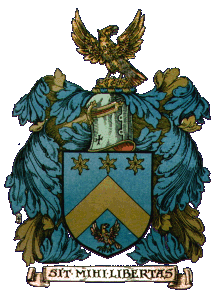ARMORIAL
BEARINGS OF FINDLATER
 Arms;
Azure a chevron Or between in chief three stars of the second and in base
an eagle reguardant proper.
Arms;
Azure a chevron Or between in chief three stars of the second and in base
an eagle reguardant proper.
Crest; on a wreath of the colours, standing on a rock an eagle reguardant
proper, charged on the breast and on each wing with a star or.
Motto;
'Sit Mihi Libertas' (Liberty be mine.)
These arms were granted
in 1863 to Alexander Findlater, who founded the wine merchants, to be used by
the children of his father John Findlater, excise officer of Greenock, Co Renfrew,
and their descendants. These are mainly Findlaters who went to Ireland and then
spread from there to England, Canada and the USA.
These arms are based on Scottish arms, believed to have been used by the family.
However no Scottish arms have been registered with the Lord Lyon King of Arms
and therefore it is not legal for them to be used in Scotland.
In these arms, we
find the stars, known as mullets in English heraldry, which are so common in
Scottish arms of the North West, as particularly exemplified by the arms of
Sutherland, gules three stars or, and Murray, azure three stars argent, ie red
with gold stars and blue with silver stars. Other similar arms are Innes of
that Ilk, argent three stars azure, or Brodie of Brodie, argent a chevron gules
between three stars azure. These arms are Murray reversed and the introduction
of a chevron into the Brodie arms suggests that they were an early cadet of
Innes.
In the symbolism of
heraldry, azure (blue) signifies both the cloudless sky and Piety and Sincerity.
It is equated with the planet Jupiter and the qualities of Justice and Purity,
also with Tuesday and with autumn. Or (gold) is the noblest colour of all. It
is equated with Sunday and with the Sun, corresponding with the virtues of richness
and noblesse. The Eagle is mainly a solar symbol, associated with Zeus and in
Roman times with military prowess and Imperium. In Christian times it became
associated with St John, for one of the beasts around the throne of God was
like a flying eagle. Charlemagne adopted it as a symbol of his position as Holy
Roman Emperor and thus it has often been used by Princes and States.
For a study of Scottish Heraldry, look at: http://www.clanmacrae.org/documents/heraldry.htm
 Arms;
Azure a chevron Or between in chief three stars of the second and in base
an eagle reguardant proper.
Arms;
Azure a chevron Or between in chief three stars of the second and in base
an eagle reguardant proper.